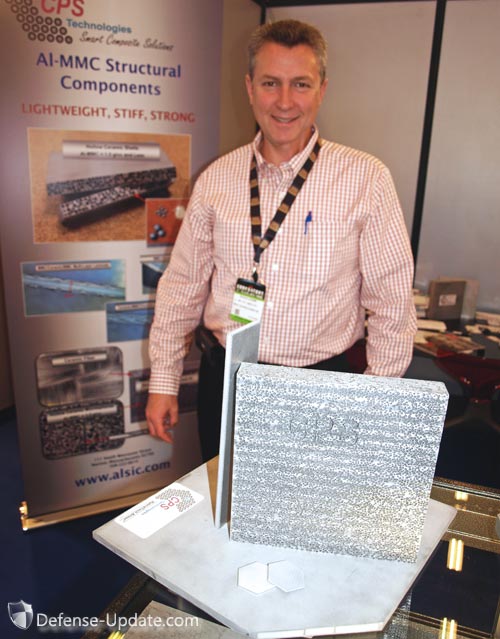CPS Technologies, a producer of advanced Metal Matrix Composites (MMC) is unveiling armor grade materials produced by this advanced process, enabling armor designers to produce ballistic and blast mitigating materials providing higher strength at lower specific weigh. The process enables the designer to increase the toughness of ceramic tiles in composite armor systems, by selectively reinforcing them with metal and metal matrix composites, the layered compound is then packaged in hermetic layers of high pressure cast aluminum. The company developed the process under a cooperative agreement with the US Army Research Lab (ARL) funding.
The technology for these new tiles and modules is an outgrowth of the company’s unique knowhow of MMC processing. The process encapsulates hybrid ceramic modules using a combination of materials to encapsulate a tile or matrix of tiles, into a by infiltrating with aluminum at high pressure.
The resulting modules are stiffer in bending, have an intimate chemical/mechanical bond between the ceramic and encapsulating material and have residual compression in the ceramic due to the differential coefficients of expansion in hermetic package. The modules are tough enough to for load bearing holes, therefore suitable to be used as structural-armor elements. The material can be produced in modules or tiles up to 1×2 meters large. The properties of these modules can be tailored according to the design, by using different elements (type or shape of ceramics, size and density of blast mitigation spheres etc.)

The company has combined various compounds in armor modules, encapsulating tiles or modules of Silicon Carbide and Alumina within the Aluminum layers, meeting specific weights of 2.8 g/cc. Other materials produced included thicker blast mitigating plates that can be used for vehicle belly protection. Such plates are combining multi-layered structures of fiber-reinforced aluminum, with hollow ceramic shells of different sizes in between, providing high energy absorption qualities at nearly half the weight of Aluminum. Similar methods are used to create firewalls made of aluminum-titanium ceramic fabric reinforced foils that have demonstrated withstanding +2000 degrees burning temperatures for over three minutes, without failure.
Photo: CPL displayed several armor modules made of aluminum-ceramic metal matrix composites. The large block shows the inner composition of a blast mitigating structural plate that can be used as for mine and IED blast belly protection. it contains hollow shperes of various sizes that absorb the shockwave as it passes through the complex structure, reducing the load levels transferred from the structure to the inner floor. An armor plate made of ceramic tiles of various sizes and shapes encapsulated with aluminum layers to form a hermetic package.
















